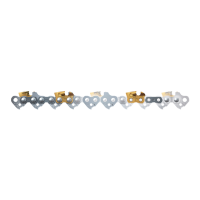24 Chain and Bar Manual
Construction
The bottoms of the cutters and tie
straps slope upwards to the rear –
this clearance between the cutters
and guide bar allow the cutters to
rock back slightly and thus produce
a shock absorbing effect.
Function
When the cutting edge makes
contact with wood, the cutter tips
back and the chain absorbs most of
the impact energy. The vibrations
during cutting are reduced by up to
70% – irrespective of the chainsaw
used.
3.14 Geometry of the Cutter
The cutter consists of
–Basic tooth body(1)
–Top plate(2)
–Depth gauge(3)
The side plate cutting edge (4) is
vertical while the top plate cutting
edge (5) is horizontal and slopes to
the rear.
The top plate and the cutting edges
have certain angles in order to
achieve optimum cutting
performance.
3.14.1 Clearance Angle of the
Top Plate
The top plate is inclined to the rear
to form the clearance angle that is
essential for the top plate cutting
edge to feed into the wood.
3.14.2 Clearance Angle of the
Side Plate
The top plate is tapered to the rear
to form the clearance angle for the
side plate cutting edge.
This angle is necessary to separate
the side of the chip from the wall of
the cut.
3.14.3 Side Plate Angle
The side plate angle denotes the
angle between the side plate cutting
edge and the horizontal line formed
by the cutter toe and heel. This
angle varies on the individual chain
types.
RAPID
TM
Micro
TM
75°
RAPID
TM
Super
TM
60°
RAPID
TM
Duro 65°
PICCO
TM
Micro
TM
75°
PICCO
TM
Super 60°
PICCO
TM
Duro 80°
RCX, RMX, PMX (ripping
chains)
75°

